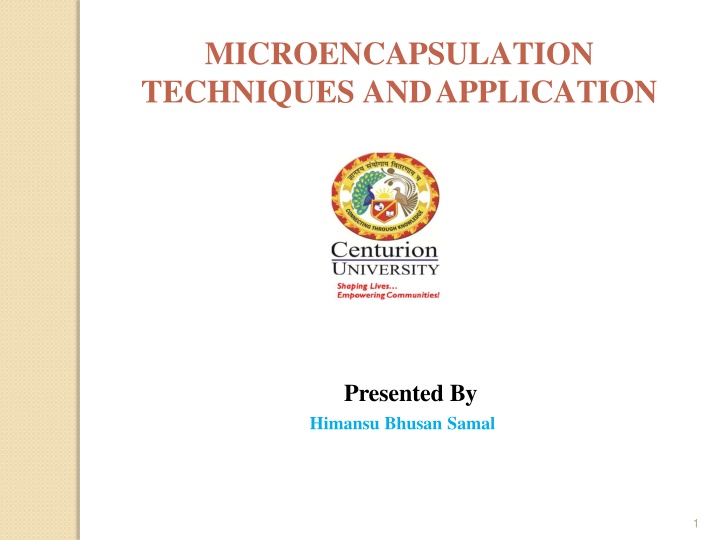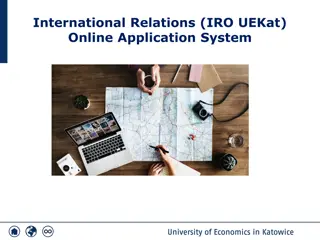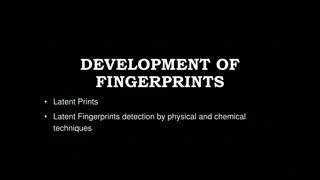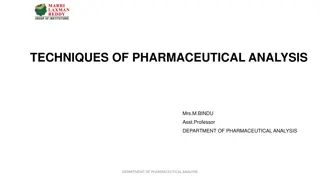
Microencapsulation Techniques and Applications Overview
Explore the process of microencapsulation, where tiny droplets or particles are coated with a film of polymeric material to form microcapsules. Learn about core and coating materials, examples of coating materials, and applications of microencapsulation in various industries.
Download Presentation

Please find below an Image/Link to download the presentation.
The content on the website is provided AS IS for your information and personal use only. It may not be sold, licensed, or shared on other websites without obtaining consent from the author. If you encounter any issues during the download, it is possible that the publisher has removed the file from their server.
You are allowed to download the files provided on this website for personal or commercial use, subject to the condition that they are used lawfully. All files are the property of their respective owners.
The content on the website is provided AS IS for your information and personal use only. It may not be sold, licensed, or shared on other websites without obtaining consent from the author.
E N D
Presentation Transcript
MICROENCAPSULATION TECHNIQUES ANDAPPLICATION Presented By Himansu Bhusan Samal 1
Contents 2 Introduction Fundamental Consideration Reason for Encapsulation Techniques of Manufacturing Microcapsule Applications References
1. Introduction 3 Definition:- MICROENCAPSULATION is a process by which very tiny droplets or particles of liquid or solid material are surrounded or coated with a continuous film of polymericmaterial. The product obtained by this process is called as Microcapsules.
4 Fig. 1: Microcapsules
5 Fundamental Consideration Generally Micro particles consist of two components a) Core material. b) Coat or wall or shell material
6 Core Material The material to be coated. It may be liquid or solid or gas. Liquid core may be dissolved or dispersedmaterial. Composition of core material: Drug or active constituent Additive like diluents Stabilizers
7 Coating Material Inert substance which coats on core with desired thickness. Composition of coating: Inert polymer Plasticizer Coloring agent Resins, waxes and lipids Release rate enhancers or retardants
8 Examples of Coating Materials 1. Water soluble resins- Gelatin, Gum Arabic, Starch, PVP, CMC, MC, Arabinogalactan, Polyvinylalcohol. 2. Water insoluble resins- EC, Polyethylene, Polymethacrylate, Polyamide (Nylon), Cellulose nitrate, Silicones. 3. Waxes and lipids- Paraffin, Carnauba, Beeswax, Stearic acid, Stearyl alcohol, Glyceryl stearates. 4. Enteric resins- Shellac, Cellulose acetate phthalate,Zein.
9 Fig. 2: Type of Core materials, Coting materials andVehicles used in Microencapsulation.
10 Core Material Aspirin Characteristic Property Purpose of Encapsulation Final Product Form Slightly water- soluble solid Taste-masking;sustained release; reducedgastric irritation; separation of incompatibles Tablet or capsule VitaminA Palmitate Isosorbide dinitrate Nonvolatile liquid Stabilization to oxidation Dry powder Water soluble solid sustained release Capsule Table 1: Properties of Some Microencapsulated Core Materials.
2. REASONS FOR ENCAPSULATION 11 The core must be isolated from its surroundings, as 1. To protect reactive substances from the environment, 2. To convert liquid active components into a dry solid system, 3. To separate incompatible components for functional reasons, 4.To protect the immediate environment of the microcapsules from the active components.
12 To control the rate at which it leaves the microcapsule, as 1. To control release of the active components for delayed (timed) release or long-acting (sustained)release, 2. The problem may be as simple as masking the taste or odor of the core, 3. To Increase of bioavailability, 4. To produce a targeted drug delivery, 5. Protects the GIT from irritant effects of the drug, 6. Extension of duration of activity for an equal level of active agent.
3. Techniques to ManufactureMicrocapsules 13 The technique of microencapsulation depends on the physical and chemical properties of the material to be encapsulated. The stability and the biological activity of the drug should not be affected, Yield and drug encapsulation efficiency should be high, Microsphere quality and drug release profile should be reproducible within specified limits, Microsphere should not exhibit aggregation or adherence, Process should be usable at an industrialscale,
14 The residual level of organic solvents should be lower than the limit value.
15 Fig. 3: MicroencapsulationTechniques.
I] Physical or Physico-mechanical methods 16 1.Air-suspension coating Inventions of Professor Dale E.Wurster Basically the wurster process consists of the dispersing of solid, particulate core materials in a supporting air stream and the spray-coating of the air suspended particles. Equipment ranging in capacities from one pound to 990pounds. Micron or submicron particles can be effectively encapsulated by air suspension techniques.
17 Disadvantage- Agglomeration of the particles to some larger size is normally achieved.
18 Processing variables for efficient, effective encapsulation by air suspension techniques: 1.Density, surface area, melting point, solubility, friability, volatility, Crystallinity, and flow-ability of core the corematerial. 2.Coating material concentration (or melting point if not a solution). 3.Coating material applicationrate. 4.Volume of air required to support and fluidizes the core material. 5.Amount of coating material required. 6.Inlet and outlet operatingtemperatures.
19 Fig. 4: Air SuspensionApparatus.
20 2. Centrifugal extrusion Liquids are encapsulated using a rotating extrusion head containing concentric nozzles. This process is excellent for forming particles 400 2,000 m in diameter. Since the drops are formed by the breakup of a liquid jet, the process is only suitable for liquid or slurry. A high production rate can be achieved, i.e., up to 22.5 kg of microcapsules can be produced per nozzle per hour per head. Heads containing 16 nozzles are available.
21 3. Pan coating Oldest industrial procedures for forming small, coated particles or tablets. The particles are tumbled in a pan or other device while the coating material is appliedslowly. Solid particles greater than 600 microns in size are generally considered essential for effective coating. Medicaments are usually coated onto various spherical substrates such as nonpareil sugar seeds, and then coated with protective layers of various polymers.
22 Fig. 5: Representation of a typical pan coating
23 4. Spray-drying In modern spray dryers the viscosity of the solutions to be sprayed can be as high as 300mPa.s Spray drying and spray congealing- dispersing the core material in a liquefied coating substance andspraying. Spray drying is effected by rapid evaporation of a solvent in which the coating material is dissolved.
24 The equipment components of a standard spray dryer include 1. an air heater, 2. atomizer, 3. main spray chamber, 4. blower or fan, 5. cyclone and 6. product collector.
25 Spray congealing can be accomplished with spray drying equipment when the protective coating is applied as a melt. Core material is dispersed in a coating material melt rather than a coating solution. Coating solidification (and microencapsulation) is accomplished by spraying the hot mixture into a cool airstream.
26 Airflow There are three modes of contact: 1. Co-current 2. Counter-current 3. Mixed-flow
27 5. VibrationalNozzle The process works very well for generating droplets between 100 5,000 m Units are deployed in industries and research mostly with capacities of 1 10,000 kg per hour at working temperatures of 20 1500 C. Nozzles heads are available from one up to several hundred thousand are available.
28 Fig. 7: Formation of Droplets Using Vibrational Nozzle Technique.
II] Physico-chemical methods 29 1. Ionotropic gelation Chemical reaction between sodium alginate and calcium chloride or other Counter ion solution such as bariumchloride. Verapamil hydrochloride causes gastric irritation on sudden release. It is usually administered as conventional tablets containing 40-120 mg, 3 times a day. Due to its ready solubility in water and shorter half-life. Microparticulate system of verapamil hydrochloride for prolonged release delivery system.
30 2. Coacervation-PhaseSeparation Patents of B.K. Green et al. Three steps carried out under continuousagitation: 1) Formation of three immiscible chemical phases 2) Deposition of the coating 3) Rigidization of the coating
31 Fig. 8: Schematic representation of the coacervation process. (a) Core material dispersion in solution of shell polymer; (b) separation of coacervate from solution; (c) coating of core material by microdroplets of coacervate; (d)coalescence of coacervate to form continuous shell around core particles.
III] Chemical process 32 1. Solvent Evaporation In the case in which the core material is dispersed in the polymer solution, polymer shrinks around the core. In the case in which core material is dissolved in the coating polymer solution, a matrix - type microcapsule is formed. The core materials may be either water - soluble or water - insoluble materials. Avariety of film - forming polymers can be used ascoatings.
33 Used by companies including the NCR Company, Gavaert Photo - Production NV, and Fuji Photo Film Co., Ltd. eg. Evaluation of Sucrose Esters as Alternative Surfactants in Microencapsulation of Proteins by the Solvent Evaporation Method.
34 2. Polymerization 1) Interfacial polymer In Interfacial polymerization, the two reactants in a polycondensation meet at an interface and reactrapidly. 2) In-situ polymerization In a few microencapsulation processes, the direct polymerization of a single monomer is carried out on the particle surface.
Continue 35 e.g. Cellulose fibers are encapsulated in polyethylene while immersed in dry toluene. Usual deposition rates are about 0.5 m/min. Coating thickness ranges 0.2-75 m. 3) Matrix polymer In a number of processes, a core material is imbedded in a polymeric matrix during formation of the particles. Prepares microcapsules containing protein solutions by incorporating the protein in the aqueous diaminephase. National Lead Corporation- utilizing polymerizationtechniques
4] Applications of Microcapsules andMicrospheres 36 1. AgriculturalApplications Reduce insect populations by disrupting their matingprocess. Protects the pheromone from oxidation and light during storage and release.
37 2. Catalysis Safe handling, easy recovery, reuse and disposal at an acceptable economic cost. Metal species such as palladium (II) acetate and osmium tetroxide have been encapsulated in polyurea microcapsules and used successfully as recoverable and reusable catalysts without significant leaching and loss of activity.
38 3. Food Industry Adding ingredients to food products to improve nutritional value can compromise their taste, colour, texture and aroma. Sometimes they slowly degrade and lose their activity, or become hazardous by oxidation reactions. Ingredients can also react with components present in the food system, which may limit bioavailability.
39 4. PharmaceuticalApplications Potential applications of this drug delivery system are replacement of therapeutic agents (not taken orally today like insulin), gene therapy and in use of vaccines for treating AIDS, tumors, cancer and diabetes. The delivery of corrective gene sequences in the form of plasmid DNA could provide convenient therapy for a number of genetic diseases such as cystic fibrosis and hemophilia.
40 Lupin has already launched in the market worlds first Cephalexin (Ceff-ER) and Cefadroxil (Odoxil OD) antibiotic tablets for treatment of bacterialinfections. Aspirin controlled release version ZORprin CR tablets are used for relieving arthritis symptoms. Quinidine gluconate CR tablets are used for treating and preventing abnormal heart rhythms. Niaspan CR tablet is used for improving cholesterol levels and thus reducing the risk for a heart attack.
41 Glucotrol (Glipizide SR) is an anti diabetic medicine used to control high blood pressure. Some of the applications of microencapsulation can be described in detail as givenbelow: 1. Prolonged release dosage forms. 2. Prepare enteric-coated dosage forms selectively absorbed in the intestine rather than the stomach. 3. It can be used to mask the taste of bitter drugs. 4. To reduce gastric irritation.
42 5. Used to aid in the addition of oily medicines to tableted dosage forms. To overcome problems inherent in producing tablets from otherwise tacky granulations. This was accomplished through improved flow properties. eg. The non-flowable multicomponent solid mixture of niacin, riboflavin, and thiamine hydrochloride and iron phosphate may be encapsulated and made directly into tablets.
43 6. To protect drugs from environmental hazards such as humidity, light, oxygen or heat. eg. vitamin A and K have been shown to be protected from moisture and oxygen through microencapsulation. 7. The separations of incompatible substances, eg. pharmaceutical eutectics. The stability enhancement of incompatible aspirin- chlorpheniramine maleate mixture was accomplished by microencapsulating both of them before mixing.
44 8. Microencapsulation can be used to decrease the volatility. 9. The hygroscopic properties of many core materials may be reduced by microencapsulation. 10.In the fabrication of multilayered tablet formulations for controlled release of medicament contained in medial layers of tableted particles. 11.Microencapsulation has also been used to decrease potential danger of handling of toxic or noxious substances. Such as fumigants, herbicides, insecticides and pesticides
5] REFERENCES 45 Leon, L., Herbert A. L., Joseph, L. K; The Theory And Practice Of I n d u s t r i a l Pharmacy , 3rd edition (1990), Varghese Publishing House, Page no.- 412-428. S.S. Bansode, a review on Microencapsulation , International Journal of Pharmaceutical Sciences Review and Research, Volume 1, Issue 2, March April 2010; Article 008; ISSN 0976 044X, Page no.- 38-43. N.K. SACHAN, a review on Drug Delivery Through Controlled Microencapsula - tion , Malaysian Journal of Pharmaceutical Sciences, Volume 4, No. 1, Page no.- 65 81 (2006). H. Umer, a review on Microencapsulation: Process, Techniques and Applications , International Journal of Research in Pharmaceutical and Biomedical Sciences, Vol. 2 (2) Apr Jun 2011, ISSN: 2229-3701, Page no.-447-481.
46 K. Shekhar, a review on MICROENCAPSULATION , International Journal of Pharmaceutical Sciences Review and Research, Volume 5, Issue 2, November December 2010; Article-012; ISSN 0976 044X, Page no.-58-62. N.V. N. Jyothi, a review on Microencapsulation Techniques, Factors Influencing Encapsulation Efficiency , The Internet Journal of Nanotechnology, (2009) Volume 3, Number 1, ISSN: 1937-8262. Simon Benita, Microencapsulation- Methods and Industrial Applications , 2 n d edition (2006), Published by CRC Press Taylor & Francis Group, Page no.-1-55. G. Murtaza, AComparative Study of Various Microencapsulation T e c h n i q u e s : Effect of Polymer Viscosity on Microcapsule Characteristics , Pak. J. Pharm. Sci., Vol.22, No.3, July 2009, Page no.- 291-300.
47 Dr. H. Patel, Ionotropic Gelation Technique For Microencapsulation of Anti-hyper- tensive Drug , WebmedCentral Pharmaceutical Sciences 2010; 1(10): WMC00922, Page no.- 1-10. R. Dubey, Microencapsulation Technology and Applications , Defence S c i e n c e Journal, Vol.59, No. 1, January 2009, Page no.- 82-95. M. Ahmad, Pharmaceutical Microencapsulation Technology for Development of Controlled Release Drug Delivery systems , World Academy of Science, Engineering and Technology,75(2011). Microtek Laboratories, Inc. www.wikipedia.com.htm
48 Jackson L. S.; Lee K. (1991-01-01). "Microencapsulation and the food i n d u s t r y" . Lebensmittle WissenschaftTechnologie. http://cat.inist.ft/?aModele=afficheN&cpsidt=5014466. Retrieved 1991-02-02.






















